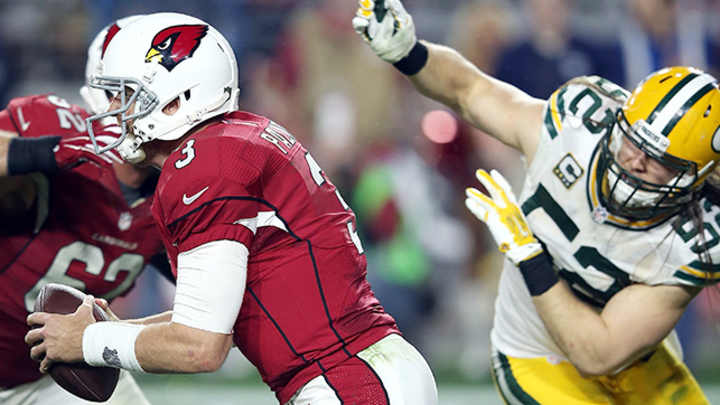When an Unlikely Play Decides an Unbelievable Game

The divisional round offered a stark reminder that in the NFL, great quarterbacking still matters more than anything. Take out Alex Smith—who, by the way, was playing mostly without top receiver Jeremy Maclin and had his passing limitations exposed by a stingy coverage-based Patriots defense—and the quarterbacks entering the weekend had a combined 43 Pro Bowls in a little more than 75 years of NFL service. All six of this year’s Pro Bowl QBs were still standing.
Eight of those Pro Bowls belong to Carson Palmer and Aaron Rodgers, who together turned in an all-time classic on Saturday night. That contest was the crispest illustration of a quarterback’s influence in pro football. Palmer battled bouts of uncharacteristic sloppiness, both mentally and physically, allowing the Packers and their anemic offense to keep the score close.
That anemic offense connected on a pair of deep-ball prayers in the closing seconds of the fourth quarter, with Rodgers finding Jeff Janis for 60 yards on fourth-and-20 and then, two snaps later, finding him again on a 41-yard Hail Mary to send the game into overtime. Both throws came with the right-handed Rodgers breaking out of the pocket to his left to release the ball. Simply incredible.
But the wild sequence at the end of regulation was a microcosm of Green Bay’s disappointing passing game this season. At that point, thanks to earlier ineptitude, the Packers were digging themselves out of a hole. The two desperation plays happened to work because Rodgers conjured magic outside of structure. It was enthralling, but it wasn’t good football. Green Bay had to rely on the magic because its passing game had again by hindered by its receivers’ mediocrity.
Some of that can be blamed on the absence of Randall Cobb and Davante Adams. But even when those guys were healthy this year, the Packers were stagnant through the air. Contrary to the popular narrative, this was not an offense that started hot, hit a road block in late October and then saw its quarterback struggle accordingly before mounting a decent postseason run. Rather, it was an offense that performed poorly in its first six games but came away victorious thanks to Rodgers’ play-making prowess. Eventually that poor play started translating into defeats (as it always does). Rodgers started regressing as the problems mounted. Then the Packers put just enough together to for a decent, but ultimately unfruitful, postseason.
Rodgers can talk about how proud he was of the team sticking together through adversity, but it was self-inflected adversity. The Packers were never good enough offensively to make it back to the NFC title game. Palmer’s 75-yard overtime completion to Larry Fitzgerald was poetic justice. It was also one of the greatest plays in NFL playoff history. Some of Palmer’s poor decisions on the night, particularly in the red zone, were confounding. And based on the handful of costly balls that got away from him, we can only assume his ailing right index finger affected his throwing. But all of it was erased by what happened on the extra period’s first snap.
The Packers on that play did not blow a coverage on Fitzgerald. They’d called an inside blitz designed to force Palmer to throw quickly. The only way Palmer could have hit Fitzgerald to beat inside pressure was if Fitzgerald ran a shallow crossing route. But the blitz accounted for that by having Julius Peppers drop into shallow coverage on the backside. As it turned out, Fitzgerald ran an “over” route, which, like a shallow cross, is a horizontal pattern. But instead of going west, an “over” route goes northwest. Peppers was not positioned to defend it. No one was. That shouldn’t have been a problem, however, because the blitz would force Palmer to throw well before Fitzgerald’s route defined itself.
What Green Bay did not account for was the possibility of Palmer eluding the blitz. Palmer moves with the suddenness of a glacier. No smart defensive coordinator would waste resources accounting for him eluding that sort of heavy pressure. When Palmer did elude it, he immediately processed everything we’ve discussed here and knew Fitzgerald would be uncovered. Theoretically, Fitzgerald should not have even been part of the quarterback’s progression at that point. Arizona’s other routes were to Palmer’s right. It took uncanny awareness to throw left.
• CARSON PALMER: A QB AND HIS GAME PLAN: PART I & PART II
This is rare, but it’s not the first time it happened. I recall a Week 7 primetime game against the Broncos in 2013 in which Andrew Luck did the same thing in a similar scenario, targeting Reggie Wayne. Unfortunately, Luck’s throw was inaccurate and Wayne tore his ACL while adjusting to the ball. But as one AFC assistant coach told me later, “Yeah, it was an inaccurate throw and an unfortunate outcome, but it’s absolutely amazing that Luck even threw to Wayne on that play to begin with. Luck had a standard three-read progression to the right side, and it was quick three-step timing. Luck knew once he eluded pressure that Wayne’s clear-out route would be uncovered on the left. Remarkable he would even think about that.”
Palmer’s progression was deeper than three-step, as his routes were more downfield than Luck’s. If anything, this makes the play more impressive. Without Palmer’s late brilliance, the Cardinals may very well have been one-and-done in these playoffs. Instead, they get to face another star quarterback (Cam Newton), with a trip to Super Bowl 50 on the line.
